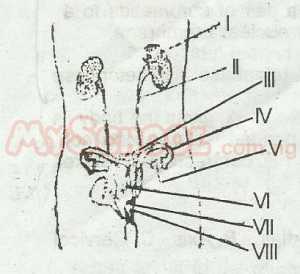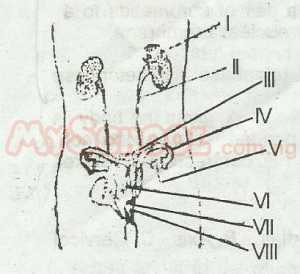Year :
1990
Title :
Biology
Exam :
WASSCE/WAEC MAY/JUNE
Paper 1 | Objectives
31 - 40 of 60 Questions
| # | Question | Ans |
|---|---|---|
| 31. |
 The structures labelled III, VI, IV and II respectively represent the A. uterus, cervix, oviduct and ureter B. cervix, oviduct, uterus and ureter C. oviduct, uterus, ureter and cervix D. vagina, cervix, oviduct and uterus E. uterus, cervix, ovary and oviduct |
A |
| 32. |
 The gamete is produced in the structure labelled A. I B. II C. IV D. VI E. V |
E |
| 33. |
What is the difference between viviparous and oviparous animals? A. Possession of yolked eggs B. Laying of unfertilized eggs C. Possession of yolkless eggs D. Protection of eggs from predator E. Laying and brooding of eggs |
E |
| 34. |
The structure of the embryo which develops and makes contact with the uterine A. umbilical cord B. placenta C. allantois D. amnion E. chorion |
A |
| 35. |
The organ located in the mammalian abdominal cavity just below the diaphragm A. bladder B. intestine C. liver D. pancreas E. chorion |
C |
| 36. |
Which of the following is the effect of using artificial pollination in plant breeding? A. Production of healthy crops B. Improvement of the variety of crops C. Making crops susceptible to diseases D. Lengthening the maturity time of crops E. Encouraging competition amongst crops |
B |
| 37. |
A dry indehiscent fruit containing one seed and possessing a hairy pappus is described as A. a nut B. a drupe C. a cypsela D. a follicle E. an achene |
C |
| 38. |
Thunderstorm can be beneficial to plants because it A. kills the pest that attacks crops B. destroys some of the major crops C. adds nitrates to the soil D. adds lime to the soil E. makes rain water available to plants |
C |
| 39. |
Which of the following is a nitrifying bacterium A. Nitrobacter B. Rhizobium C. Azotobacter D. Clostribium E. Nitrosomonas |
A |
| 40. |
Which of the following reagents is used for the test for starch? A. Million’s reagent B. Fehling’s’ solution C. Sudan III D. Iodine solution E. Benedict’s solution |
D |
| 31. |
 The structures labelled III, VI, IV and II respectively represent the A. uterus, cervix, oviduct and ureter B. cervix, oviduct, uterus and ureter C. oviduct, uterus, ureter and cervix D. vagina, cervix, oviduct and uterus E. uterus, cervix, ovary and oviduct |
A |
| 32. |
 The gamete is produced in the structure labelled A. I B. II C. IV D. VI E. V |
E |
| 33. |
What is the difference between viviparous and oviparous animals? A. Possession of yolked eggs B. Laying of unfertilized eggs C. Possession of yolkless eggs D. Protection of eggs from predator E. Laying and brooding of eggs |
E |
| 34. |
The structure of the embryo which develops and makes contact with the uterine A. umbilical cord B. placenta C. allantois D. amnion E. chorion |
A |
| 35. |
The organ located in the mammalian abdominal cavity just below the diaphragm A. bladder B. intestine C. liver D. pancreas E. chorion |
C |
| 36. |
Which of the following is the effect of using artificial pollination in plant breeding? A. Production of healthy crops B. Improvement of the variety of crops C. Making crops susceptible to diseases D. Lengthening the maturity time of crops E. Encouraging competition amongst crops |
B |
| 37. |
A dry indehiscent fruit containing one seed and possessing a hairy pappus is described as A. a nut B. a drupe C. a cypsela D. a follicle E. an achene |
C |
| 38. |
Thunderstorm can be beneficial to plants because it A. kills the pest that attacks crops B. destroys some of the major crops C. adds nitrates to the soil D. adds lime to the soil E. makes rain water available to plants |
C |
| 39. |
Which of the following is a nitrifying bacterium A. Nitrobacter B. Rhizobium C. Azotobacter D. Clostribium E. Nitrosomonas |
A |
| 40. |
Which of the following reagents is used for the test for starch? A. Million’s reagent B. Fehling’s’ solution C. Sudan III D. Iodine solution E. Benedict’s solution |
D |